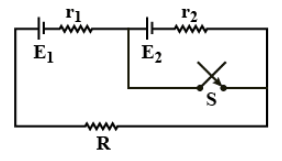
Switch $S$ is closed at time $t=0$. Which of the following statements is correct?

A. Current in the resistance R increases if \[{E_1}{r_2} < {E_2}(R + {r_1})\]
B. Current in the resistance R increases if \[{E_1}{r_2} > {E_2}(R + {r_1})\]
C. Current in the resistance R decreases if \[{E_1}{r_2} = {E_2}(R + {r_1})\]
D. Current in the resistance R increases if \[{E_1}{r_2} = {E_2}(R + {r_1})\]

Answer
503.4k+ views
Hint: An electric switch is a system that can either make or break an electrical circuit. When a switch makes or completes a circuit and allows current to flow through, it is assumed to be in the 'ON' state. A switch is in the 'OFF' state as it splits the circuit and prevents current from flowing into it.
Complete step by step answer:
To measure an unknown electrical resistance, a Wheatstone bridge is an electrical circuit that balances two legs of a bridge circuit, one of which contains the unknown component. The ability to make extremely accurate calculations is the circuit's greatest benefit (in contrast with something like a simple voltage divider). It functions in the same manner as the first potentiometer.
The initial current, also known as initialization current, is the current drawn by the battery when it is connected to a charger for the first time. In most cases, the original charge current is significantly lower than the constant charge current. In most cases, the original charge current is significantly lower than the constant charge current. Switch $S$ is closed at time $t=0$.
Before closing the switch the initial current is given as = \[{i_1} = \dfrac{{{E_1} + {E_2}}}{{R + {r_1} + {r_2}}}\]
When the second battery is short-circuited, then the final current is,
\[{i_2} = \dfrac{{{E_1}}}{{R + {r_1}}}\]
By comparing the above 2 equations we get
\[{i_2} > {i_1}\]
\[\Rightarrow \dfrac{{{E_1}}}{{R + {r_1}}} > \dfrac{{{E_1} + {E_2}}}{{R + {r_1} + {r_2}}}\]
\[\Rightarrow {E_1}R + {E_1}{r_1} + {E_1}{r_2} > {E_1}R + {E_1}{r_1} + {E_2}R + {E_2}{r_1}\]
\[\therefore {E_1}{r_2} > {E_2}\left( {R + {r_1}} \right)\]
Hence, option B is correct.
Note: Resistance is a measurement of the resistance to current flow in an electrical circuit. Resistance in ohms is expressed by the Greek letter omega ($\Omega $). Ohms was named after Georg Simon Ohm (1784-1854), a German physicist who studied the relationship between voltage, current, and resistance.
Complete step by step answer:
To measure an unknown electrical resistance, a Wheatstone bridge is an electrical circuit that balances two legs of a bridge circuit, one of which contains the unknown component. The ability to make extremely accurate calculations is the circuit's greatest benefit (in contrast with something like a simple voltage divider). It functions in the same manner as the first potentiometer.
The initial current, also known as initialization current, is the current drawn by the battery when it is connected to a charger for the first time. In most cases, the original charge current is significantly lower than the constant charge current. In most cases, the original charge current is significantly lower than the constant charge current. Switch $S$ is closed at time $t=0$.
Before closing the switch the initial current is given as = \[{i_1} = \dfrac{{{E_1} + {E_2}}}{{R + {r_1} + {r_2}}}\]
When the second battery is short-circuited, then the final current is,
\[{i_2} = \dfrac{{{E_1}}}{{R + {r_1}}}\]
By comparing the above 2 equations we get
\[{i_2} > {i_1}\]
\[\Rightarrow \dfrac{{{E_1}}}{{R + {r_1}}} > \dfrac{{{E_1} + {E_2}}}{{R + {r_1} + {r_2}}}\]
\[\Rightarrow {E_1}R + {E_1}{r_1} + {E_1}{r_2} > {E_1}R + {E_1}{r_1} + {E_2}R + {E_2}{r_1}\]
\[\therefore {E_1}{r_2} > {E_2}\left( {R + {r_1}} \right)\]
Hence, option B is correct.
Note: Resistance is a measurement of the resistance to current flow in an electrical circuit. Resistance in ohms is expressed by the Greek letter omega ($\Omega $). Ohms was named after Georg Simon Ohm (1784-1854), a German physicist who studied the relationship between voltage, current, and resistance.
Recently Updated Pages
A man running at a speed 5 ms is viewed in the side class 12 physics CBSE

The number of solutions in x in 02pi for which sqrt class 12 maths CBSE

State and explain Hardy Weinbergs Principle class 12 biology CBSE

Write any two methods of preparation of phenol Give class 12 chemistry CBSE

Which of the following statements is wrong a Amnion class 12 biology CBSE

Differentiate between action potential and resting class 12 biology CBSE

Trending doubts
What are the major means of transport Explain each class 12 social science CBSE

Which are the Top 10 Largest Countries of the World?

Draw a labelled sketch of the human eye class 12 physics CBSE

How much time does it take to bleed after eating p class 12 biology CBSE

Explain sex determination in humans with line diag class 12 biology CBSE

Explain sex determination in humans with the help of class 12 biology CBSE




